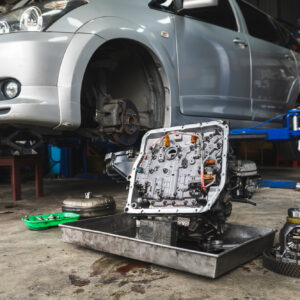The transmission is part of the engine’s drivetrain, which transfers power from the engine to the wheels. Transmission gears allow the engine to spin the wheels at a range of speeds. A transmission can last the entire lifespan of the vehicle. However, some vehicles can have major transmission issues requiring a transmission rebuild or replacement.
How Long Does It Take to Replace a Transmission?
Installing a new or rebuilt transmission is a complicated task. Transmission replacement typically requires one or two days, depending on the type of transmission.
The vehicle’s make and model will also play a role, as some vehicle transmissions are more complicated. In these cases, replacing a transmission can take up to three or four days.
It’ll also take more time to get your vehicle back on the road if you’re replacing internal components rather than getting the whole transmission assembly replaced.
A Note of Caution from Richard McCuistian, ASE Certified Master Automobile Technician
A professional that does the job every day with a lift and the right tools can do it in as little as an hour, but it may take longer on some vehicles. But if you’re working at home, be extremely careful through every phase of the job, take your time, and don’t get hurt. Transmissions are heavy and they can hurt you really bad if you’re trying to do the job without proper lifting tools to handle the transmission.
Mechanics work on commission, so don’t expect the shop to charge for the time the mechanic spent on it. He’s getting paid for his experience, speed and efficiency, which is the industry standard nationwide, and it’s a fair system.
How Long Does Transmission Repair Take?
If you’re getting your vehicle’s transmission repaired at a shop, the repair might take longer because shops can have queues. This means your vehicle will only be worked on when mechanics are finished working on other vehicles.
Also, take note that there’s a difference between “repair” and a simple removal and replacement. If the transmission is being rebuilt or is having some internal part replaced, it takes a lot longer than simply doing a transmission swap.
A transmission replacement might require 10 hours of continuous work to replace, but your vehicle might spend several days or more in a shop, depending on the queue and whatever else is being done to the transmission once it’s removed.
Replacing Rear-Wheel Drive Transmissions Is Easier
Transmission repair times also vary depending on the transmission type. The transmission of front-wheel drive vehicles is located under the hood, beside the engine. Meanwhile, rear-wheel drive vehicles have the transmission underneath the front passenger seats. In short, replacing a rear-wheel drive transmission is generally easier because there aren’t a lot of parts in the way.
But note that neither of these statements is absolute. For example, a four-wheel-drive vehicle may need the torsion bars removed, and the front part of the exhaust system just about always needs to be removed, which can be a huge undertaking all by itself.
Typical Steps in Removing a Transmission
Let’s walk our way through the steps of removing a rear-wheel-drive transmission so you can get an idea of what the mechanic has to do.
First, note that a front-wheel-drive vehicle typically needs the H frame that supports the engine and transmission removed (and sometimes parts of the exhaust system). On some vehicles, the lower control arms are connected to the H frame. Further, on most front-wheel-drive transverse engines, the engine needs to be supported with a special tool during this process.
Some mechanics will disconnect everything from the engine and the transmission and lower the entire powertrain along with the H frame using a powertrain lift.
The transmission assembly of front-wheel drive vehicles is typically integrated with the engine and axles. Hence, mechanics will need to unbolt the engine and disconnect the axles to remove the transmission. Overall, these tasks can add up to a day’s worth of work.
Meanwhile, rear-wheel drive transmissions are located under the vehicle. Mechanics can readily access the transmission assembly when the vehicle is raised.
Next Steps in Replacing a Transmission
A mechanic could do the following steps to replace a transmission:
- Remove the starter and any metal covers required to access the torque converter bolts.
- Without turning the engine backwards (this is important), remove the torque converter bolts one at a time. When they’re all removed, push the converter back away from the flex plate. Disconnect all linkage and wiring from the transmission.
- When you’re looking at the front of the engine, it will turn clockwise, and only turn it in that direction or you may cause the engine to jump time (this happens sometimes, believe it or not). Use a breaker bar on the harmonic balancer bolt to turn the engine.
- The transmission should be supported so the crossmember can be removed. Use a transmission jack to support the transmission while removing the crossmember.
- Before removing the crossmember, remove the driveshaft and set it aside.
- Securely pack racks in the extension housing around the splined shaft and then tape heavy plastic garbage bags over the rear extension housing to prevent fluid loss.
- If it’s a four-wheel-drive, disconnect the front driveshaft and all linkage, wires, and cable from the transfer case.
- Remove the transmission bell housing bolts (long extension and a wiggler helps) and with it securely strapped to the transmission jack so it won’t fall off, work it loose from the engine and lower it.
- Reverse the above steps to reinstall the transmission.
Frequently Asked Questions
What Factors Can Affect the Time Needed for Transmission Replacement?
If you’re replacing or repairing a transmission, remember that you also need time to get the right replacement transmission. This can be a tedious process on its own because transmission components might not be readily available.
The mechanic’s skill level is also another thing to consider. Some shops might be more familiar and experienced when working on transmissions.
Is Replacing a Manual Transmission Easier Compared to an Automatic?
Automatic transmissions have more components. Its complexity is going to make repairs more time-consuming.
Can Transmission Repair Take Longer Than a Week?
Yes. Replacing a transmission can take longer than a week if there are parts that need to be ordered or if the shop has a queue.
Long repair times can be quite common since transmission repairs typically involve ordering transmission components. Sometimes, dealerships can take months to repair a transmission because parts can take some time to arrive.
Some shops might also repeatedly put your vehicle at the back of the queue in favor of easier and more urgent repairs.
Are There Ways to Expedite the Transmission Replacement Process?
Transmission repair and replacement is a complicated process that requires an experienced mechanic. You can’t conduct the repair yourself, but you can make the repair process fast by keeping in touch with your mechanic and promptly authorizing the purchase of parts and repairs.
Choosing a reliable shop that doesn’t have a long customer queue can also contribute to a faster repair process.
Where to Find High-Quality Transmission Parts for Your Daily Driver
When it’s time to shop for transmission fluid, shaft seals, gears, or a brand-new transmission control module, CarParts.com is the best place to be. We have everything you need to get your vehicle back on the road, fast.
Simply enter your vehicle’s year, make, and model into our vehicle selector to start shopping for OE-grade transmission parts. Choose products from only the best manufacturers today. All our transmission parts passed strict quality checks from industry professionals, so you’re sure to get parts built to last.
Never worry about going over budget when you shop from us. Products come with price match and lifetime replacement guarantees, helping you get the best value for your money. Order now, and we’ll deliver everything you need straight to your doorstep in as fast as two business days.
Don’t waste another day leaving your car cooped up in the garage, and shop from CarParts.com today!
Any information provided on this Website is for informational purposes only and is not intended to replace consultation with a professional mechanic. The accuracy and timeliness of the information may change from the time of publication.

































